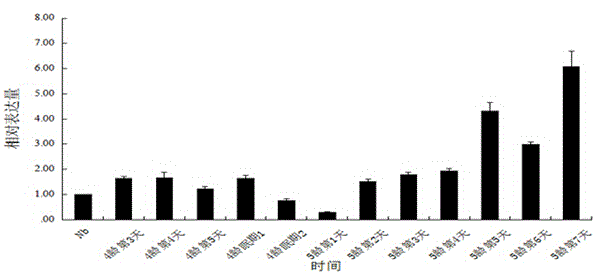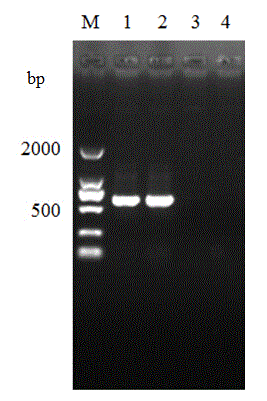Application of septin1 gene to detection of nosema bombycis
A technology of microsporidia and silkworm, applied in the application field of septin1 gene in the detection of microsporidia of silkworm, can solve the problems of interference with effective amplification of PCR, etc., and achieve the effect of strong specificity, high specificity and high sensitivity
- Summary
- Abstract
- Description
- Claims
- Application Information
AI Technical Summary
Problems solved by technology
Method used
Image
Examples
Embodiment 1
[0037] Example 1 septin1 Gene function research
[0038] The inventors are developing silkworm microsporidia N. bombycis (Guangdong strain) based on the transcriptomic research, the results of the transcriptome sequencing analysis were identified for the first time that may be related to the N. bombycis infection, reproduction Septins genes, named respectively septin1 (Accession: KF421133.1), septin2 (Accession: KJ451481.1), septin3 (Accession: KJ451482.1). In this example, the infection of silkworm Microsporidia N. bombycis The silkworm larvae, eggs and other developmental stages were carried out septin1 differential expression analysis.
[0039] The test method was as follows: silkworms from the 4th instar (Bombyx mori variety: Liangguang No. 2) were fed with Microsporidia of Bombyx mori, once in the morning and once in the evening, and then raised normally thereafter. After poisoning, the silkworms fed with poisoning were randomly selected every day (from ...
Embodiment 2
[0047] Example 2 Septin1 Application of genes as target genes for detecting whether silkworm eggs are infected with silkworm Microsporidia
[0048] (1) Extraction of total DNA from silkworm eggs
[0049] Genomic DNA was extracted using the DNeasy Plant mini kit produced by QIAGEN. The steps are as follows:
[0050] A. Take 20 silkworm eggs and put them in a mortar, fully grind with liquid nitrogen, and collect the ground powder into a 1.5mL centrifuge tube;
[0051] B. Add 400 μL AP1 and 4 μL RNase, and mix by vortexing (do not mix 400 μL APL and 4 μL RNase before use); after mixing, incubate the mixed solution at 65°C for 10 min (invert the tube upside down for 2-3 Second-rate);
[0052] C. Add 130 μL AP2, mix and cool on ice for 5 min; then centrifuge at 14 000 rpm for 5 min;
[0053] D. Pipette the supernatant into the collection tube of the QIA shredder spin column, centrifuge at 14 000rpm for 2min;
[0054] E. Transfer the supernatant from the ...
Embodiment 3 Embodiment 2
[0066] Example 3 Specific detection of primers described in Example 2
[0067]Take 30 "toxic" silkworm eggs, healthy silkworm eggs and purified silkworm microsporidia, respectively, extract total DNA according to the method of Example 2, then carry out PCR amplification, and use agarose gel electrophoresis to detect the results. Test results such as figure 1 Shown: DNA fragments of 699 bp were detected in "toxic" silkworm eggs and purified silkworm microsporidia, while no DNA fragments of 699 bp were detected in healthy silkworm eggs. Except for the N.b-specific target band of about 699 bp amplified by the septin1R primer, there are no other heterobands of different sizes from the target fragment. septin1 The gene is used as the detection target gene. The inhibitory substances in the silkworm egg extract will not interfere with the effective PCR amplification of the pathogenic gene DNA, and the detection results are more accurate and sensitive. It can quickly detect wheth...
PUM
 Login to View More
Login to View More Abstract
Description
Claims
Application Information
 Login to View More
Login to View More - R&D
- Intellectual Property
- Life Sciences
- Materials
- Tech Scout
- Unparalleled Data Quality
- Higher Quality Content
- 60% Fewer Hallucinations
Browse by: Latest US Patents, China's latest patents, Technical Efficacy Thesaurus, Application Domain, Technology Topic, Popular Technical Reports.
© 2025 PatSnap. All rights reserved.Legal|Privacy policy|Modern Slavery Act Transparency Statement|Sitemap|About US| Contact US: help@patsnap.com



